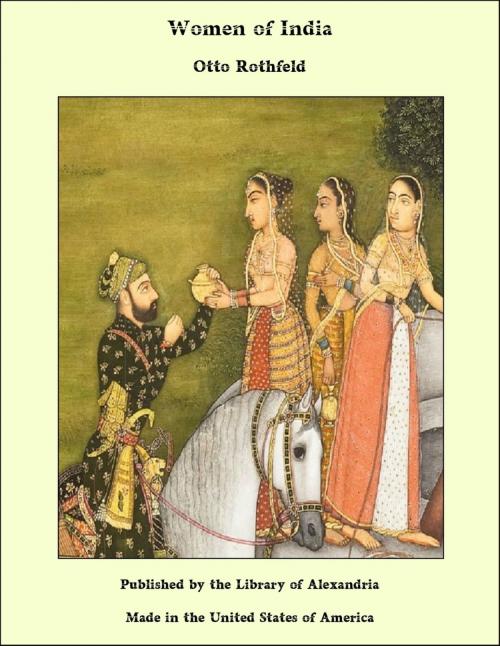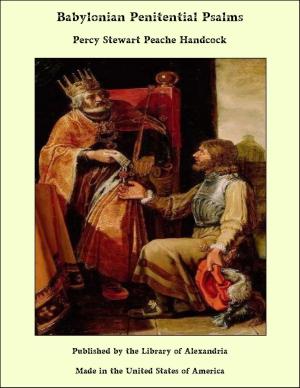| Author: | Otto Rothfeld | ISBN: | 9781465626578 |
| Publisher: | Library of Alexandria | Publication: | March 8, 2015 |
| Imprint: | Language: | English |
| Author: | Otto Rothfeld |
| ISBN: | 9781465626578 |
| Publisher: | Library of Alexandria |
| Publication: | March 8, 2015 |
| Imprint: | |
| Language: | English |
Others had written even before Vatsyana the Wise wrote his “Gospel of Love.” At that time the power of the Yávans and the Sákas was outstretched over the land. They were peoples that had come out of Persia and Bactria and obscure Scythia, many of them men with the blood of those Ionian soldiers who had marched with Alexander and settled with Eastern wives under Eastern skies. The teachings of Gautama, the Indian prince, they had made their own; and to the countries in which they ruled they had brought the peace of Buddha and the temperate fruitions of Greece. On all the great trade-routes were monasteries of Buddhist monks and large caravanserais for merchants and pilgrims. Even as far as the sands of Lopnor, far across the roof of the world, and to the Gobi desert, where the Chinese land begins, the tribes that gave rulers to India had set their posts and planted their colonies. On cunningly-sealed wedges of wood they sent their royal orders to the wardens of their frontiers and on palm-leaves from the Indian coasts they inscribed the lore that gave the illumination of God to settlements on the mountains and in the Central Asian deserts. In the shrines or stupas that they raised to Buddha, the wise teacher, they had dadoes and frescoes painted in tempera by some Titianus or Heliodorus from the Hellenized Levant, adventurers of a fine Grecian courage, who scattered their harmonious energies and their joy in life over the Indian world. Along the trade-routes marched merchants’ caravans, burdened with silks and rare spices, that found their way from China to the Black Sea or the precarious ports on the Arabian Coast. “Women,” wrote the professors of love, in that time of peace and enjoyment, “can be divided into four classes. There is she who is a pure lotus, and she who is fair as a picture, she whom they call hag and witch, and she who can be likened only to the female of the elephant.” Of her who is as a lotus they wrote:“Her face is pleasant, like the full moon: her plump body is tender as the mustard flower: her skin is fine and soft as the golden lotus, fair and undarkened. Bright and beautiful are her eyes like those of the antelope, clear-cut and healthful. Her breast is firm and full and uplifted, and her neck shapely: her nose is straight and delightful. The scent of her body is like a lily newly burst. She walks delicately like a swan and her voice is low and musical as the note of the cuckoo, calling softly in the summer day. She is clothed in clean white garments and she delights in rich jewels and adornments. She is gracious and clever, pious and respectful, a lover of God, a listener to the virtuous and the wise.”
Others had written even before Vatsyana the Wise wrote his “Gospel of Love.” At that time the power of the Yávans and the Sákas was outstretched over the land. They were peoples that had come out of Persia and Bactria and obscure Scythia, many of them men with the blood of those Ionian soldiers who had marched with Alexander and settled with Eastern wives under Eastern skies. The teachings of Gautama, the Indian prince, they had made their own; and to the countries in which they ruled they had brought the peace of Buddha and the temperate fruitions of Greece. On all the great trade-routes were monasteries of Buddhist monks and large caravanserais for merchants and pilgrims. Even as far as the sands of Lopnor, far across the roof of the world, and to the Gobi desert, where the Chinese land begins, the tribes that gave rulers to India had set their posts and planted their colonies. On cunningly-sealed wedges of wood they sent their royal orders to the wardens of their frontiers and on palm-leaves from the Indian coasts they inscribed the lore that gave the illumination of God to settlements on the mountains and in the Central Asian deserts. In the shrines or stupas that they raised to Buddha, the wise teacher, they had dadoes and frescoes painted in tempera by some Titianus or Heliodorus from the Hellenized Levant, adventurers of a fine Grecian courage, who scattered their harmonious energies and their joy in life over the Indian world. Along the trade-routes marched merchants’ caravans, burdened with silks and rare spices, that found their way from China to the Black Sea or the precarious ports on the Arabian Coast. “Women,” wrote the professors of love, in that time of peace and enjoyment, “can be divided into four classes. There is she who is a pure lotus, and she who is fair as a picture, she whom they call hag and witch, and she who can be likened only to the female of the elephant.” Of her who is as a lotus they wrote:“Her face is pleasant, like the full moon: her plump body is tender as the mustard flower: her skin is fine and soft as the golden lotus, fair and undarkened. Bright and beautiful are her eyes like those of the antelope, clear-cut and healthful. Her breast is firm and full and uplifted, and her neck shapely: her nose is straight and delightful. The scent of her body is like a lily newly burst. She walks delicately like a swan and her voice is low and musical as the note of the cuckoo, calling softly in the summer day. She is clothed in clean white garments and she delights in rich jewels and adornments. She is gracious and clever, pious and respectful, a lover of God, a listener to the virtuous and the wise.”















